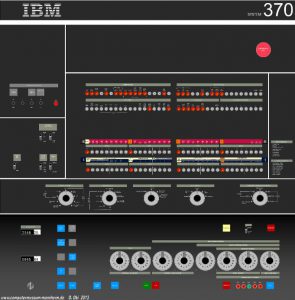 This amusing and exhaustive treatment of the vagaries of English spelling and pronunciation comes from LA jokemeister Michael Klein, who says, “Get through this without having to unwind your tongue once or twice! I still can’t speak a day later!” BTW this piece looks British, judging from some of the spelling; if you are American, it will enhance your reading if you know that many Brits pronounce the word “ate” as though it were spelled (spelt?) “et.”
This amusing and exhaustive treatment of the vagaries of English spelling and pronunciation comes from LA jokemeister Michael Klein, who says, “Get through this without having to unwind your tongue once or twice! I still can’t speak a day later!” BTW this piece looks British, judging from some of the spelling; if you are American, it will enhance your reading if you know that many Brits pronounce the word “ate” as though it were spelled (spelt?) “et.”Multi-national personnel at North Atlantic Treaty Organization headquarters near Paris found English to be an easy language … until they tried to pronounce it. To help them discard an array of accents, the verses below were devised. After trying them, a Frenchman said he’d prefer six months at hard labor to reading six lines aloud. Try them yourself.
ENGLISH IS TOUGH STUFF
Dearest creature in creation,
Study English pronunciation.
I will teach you in my verse
Sounds like corpse, corps, horse, and worse.
I will keep you, Suzy, busy,
Make your head with heat grow dizzy.
Tear in eye, your dress will tear.
So shall I! Oh hear my prayer.
Just compare heart, beard, and heard,
Dies and diet, lord and word,
Sword and sward, retain and Britain.
(Mind the latter, how it’s written.)
Now I surely will not plague you
With such words as plaque and ague.
But be careful how you speak:
Say break and steak, but bleak and streak;
Cloven, oven, how and low,
Script, receipt, show, poem, and toe.
Hear me say, devoid of trickery,
Daughter, laughter, and Terpsichore,
Typhoid, measles, topsails, aisles,
Exiles, similes, and reviles;
Scholar, vicar, and cigar,
Solar, mica, war and far;
One, anemone, Balmoral,
Kitchen, lichen, laundry, laurel;
Gertrude, German, wind and mind,
Scene, Melpomene, mankind.
Billet does not rhyme with ballet,
Bouquet, wallet, mallet, chalet.
Blood and flood are not like food,
Nor is mould like should and would.
Viscous, viscount, load and broad,
Toward, to forward, to reward.
And your pronunciation’s OK
When you correctly say croquet,
Rounded, wounded, grieve and sieve,
Friend and fiend, alive and live.
Ivy, privy, famous, clamour
And enamour rhyme with hammer.
River, rival, tomb, bomb, comb,
Doll and roll and some and home.
Stranger does not rhyme with anger,
Neither does devour with clangour.
Souls but foul, haunt but aunt,
Font, front, wont, want, grand, and grant,
Shoes, goes, does. Now first say finger,
And then singer, ginger, linger,
Real, zeal, mauve, gauze, gouge and gauge,
Marriage, foliage, mirage, and age.
Query does not rhyme with very,
Nor does fury sound like bury.
Dost, lost, post and doth, cloth, loth.
Job, nob, bosom, transom, oath.
Though the differences seem little,
We say actual but victual.
Refer does not rhyme with deafer.
Foeffer does, and zephyr, heifer.
Mint, pint, senate and sedate;
Dull, bull, and George ate late.
Scenic, Arabic, Pacific,
Science, conscience, scientific.
Liberty, library, heave and heaven,
Rachel, ache, moustache, eleven.
We say hallowed, but allowed,
People, leopard, towed, but vowed.
Mark the differences, moreover,
Between mover, cover, clover;
Leeches, breeches, wise, precise,
Chalice, but police and lice;
Camel, constable, unstable,
Principle, disciple, label.
Petal, panel, and canal,
Wait, surprise, plait, promise, pal.
Worm and storm, chaise, chaos, chair,
Senator, spectator, mayor.
Tour, but our and succour, four.
Gas, alas, and Arkansas.
Sea, idea, Korea, area,
Psalm, Maria, but malaria.
Youth, south, southern, cleanse and clean.
Doctrine, turpentine, marine.
Compare alien with Italian,
Dandelion and battalion.
Sally with ally, yea, ye,
Eye, I, ay, aye, whey, and key.
Say aver, but ever, fever,
Neither, leisure, skein, deceiver.
Heron, granary, canary.
Crevice and device and aerie.
Face, but preface, not efface.
Phlegm, phlegmatic, ass, glass, bass.
Large, but target, gin, give, verging,
Ought, out, joust and scour, scourging.
Ear, but earn and wear and tear
Do not rhyme with here but ere.
Seven is right, but so is even,
Hyphen, roughen, nephew Stephen,
Monkey, donkey, Turk and jerk,
Ask, grasp, wasp, and cork and work.





 This amusing and exhaustive treatment of the vagaries of English spelling and pronunciation comes from LA jokemeister Michael Klein, who says, “Get through this without having to unwind your tongue once or twice! I still can’t speak a day later!” BTW this piece looks British, judging from some of the spelling; if you are American, it will enhance your reading if you know that many Brits pronounce the word “ate” as though it were spelled (spelt?) “et.”
This amusing and exhaustive treatment of the vagaries of English spelling and pronunciation comes from LA jokemeister Michael Klein, who says, “Get through this without having to unwind your tongue once or twice! I still can’t speak a day later!” BTW this piece looks British, judging from some of the spelling; if you are American, it will enhance your reading if you know that many Brits pronounce the word “ate” as though it were spelled (spelt?) “et.” But, as usual, times change. We are faced today with a world in which little old ladies can get computers in their microwave ovens, 12 year old kids can blow Real Men out of the water playing Asteroids and Pac-Man, and anyone can buy and understand their very own Personal Computer. The Real Programmer is in danger of becoming extinct, of being replaced by high school students with TRS-80s.
But, as usual, times change. We are faced today with a world in which little old ladies can get computers in their microwave ovens, 12 year old kids can blow Real Men out of the water playing Asteroids and Pac-Man, and anyone can buy and understand their very own Personal Computer. The Real Programmer is in danger of becoming extinct, of being replaced by high school students with TRS-80s.

